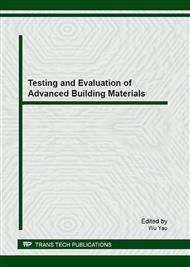p.145
p.149
p.153
p.158
p.166
p.172
p.178
p.184
p.189
Research on Modification of Steady State Migration Test for Cementitious Materials
Abstract:
Steady state migration test is the main method for determining chloride diffusivity of cementitious materials. In this paper a modified steady state migration test was introduced. The conductivity of anolyte is tested to calculate chloride concentration therefore the time consuming work for determining chloride concentration directly is avoided and the steady state migration test is simplified. A series of concrete mixes with different water cement ratio and different mineral admixtures were tested with the modified steady state migration test. An equation for calculation of chloride concentration using conductivity of anolyte is given. Experimental results show that the modified steady state migration test is effective and convenient. Probable experimental errors caused by determining chloride concentration directly are averted by conductivity determining.
Info:
Periodical:
Pages:
166-171
Citation:
Online since:
January 2013
Authors:
Price:
Сopyright:
© 2013 Trans Tech Publications Ltd. All Rights Reserved
Share:
Citation:


